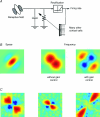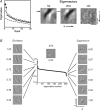Mapping receptive fields in primary visual cortex
- PMID: 15155794
- PMCID: PMC1665021
- DOI: 10.1113/jphysiol.2004.065771
Mapping receptive fields in primary visual cortex
Abstract
Nearly 40 years ago, in the pages of this journal, Hubel and Wiesel provided the first description of receptive fields in the primary visual cortex of higher mammals. They defined two classes of cortical cells, "simple" and "complex", based on neural responses to simple visual stimuli. The notion of a hierarchy of receptive fields, where increasingly intricate receptive fields are constructed from more elementary ones, was introduced. Since those early days we have witnessed the birth of quantitative methods to map receptive fields and mathematical descriptions of simple and complex cell function. Insights gained from these models, along with new theoretical concepts, are refining our understanding of receptive field structure and the underlying cortical circuitry. Here, I provide a brief historical account of the evolution of receptive field mapping in visual cortex along with the associated conceptual advancements, and speculate on the shape novel theories of the cortex may take as a result these measurements.
Figures




References
-
- Abbott LF, Chance FS. Rethinking the taxonomy of visual neurons. Nat Neurosci. 2002;5:391–392. - PubMed
-
- Adelson EH, Bergen JR. Spatiotemporal energy models for the perception of motion. J Opt Soc Am A. 1985;2:284–299. - PubMed
-
- Albrecht DG, Geisler WS. Motion selectivity and the contrast-response function of simple cells in the visual cortex. Vis Neurosci. 1991;7:825–837. - PubMed
-
- Albrecht DG, Geisler WS, Crane AM. Nonlinear properties of visual cortex neurons: Temporal dynamics, stimulus selectivity, neural performance. In: Chalupa L, Werner J, editors. The Visual Neurosciences. Boston: MIT Press; 2003. pp. 825–837.
-
- Anzai A, Ohzawa I, Freeman RD. Neural mechanisms for processing binocular information I. Simple cells. J Neurophysiol. 1999;82:891–908. - PubMed
Publication types
MeSH terms
LinkOut - more resources
Full Text Sources

